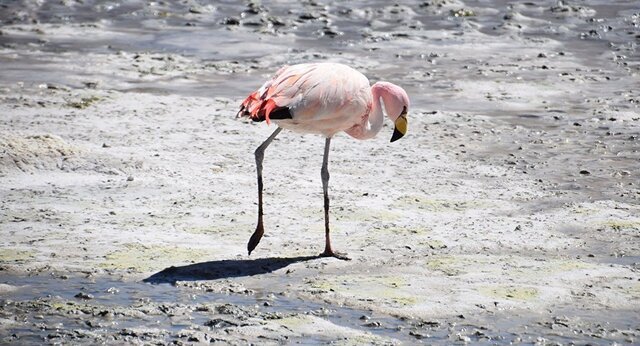High salinity of Lake Urmia reduces flamingo population

TEHRAN – The population of flamingos in Lake Urmia National Park has decreased by 30 to 35 percent due to the lack of proper living conditions, mainly as a result of the lake’s high salinity, Omid Yousefi, head of the wildlife surveillance of West Azarbaijan’s department of environment, stated.
Noting that this year, 35 to 40 thousand flamingos were counted in Lake Urmia islands, he highlighted that in recent years, the lake was host to 50 to 60 thousand flamingos, which significantly dropped this year due to lack of living conditions and high salt concentration.
In previous years, the annual increase in the population of flamingos and the presence of other bird species increased by an average of about 10 to 15 percent, he said adding, the existence of suitable biological conditions, especially food availability and habitat security, in the early months of this year had caused flamingos to breed, but unfortunately hypersalinity of the lake had a negative impact on the population.
According to field studies, the population of birds in this habitat has decreased significantly, although the flamingo chicks of the remaining population, which feed mainly on Artemia, are hatching.
Teams of experts and rangers are currently collecting trapped birds inside the lake and releasing them into surrounding wetlands after washing the salt that settled on their bodies, he explained.
Flamingos are a type of wading bird in the family Phoenicopteridae, four flamingo species are distributed throughout the Americas, including the Caribbean, and two species are native to Africa, Asia, and Europe.
Flamingos are very social birds; they live in colonies whose population can number in the thousands. These large colonies are believed to serve three purposes for the flamingos: avoiding predators, maximizing food intake, and using scarcely suitable nesting sites more efficiently. Before breeding, flamingo colonies split into breeding groups of about 15 to 50 birds.
Lake Urmia condition
Shared between West Azarbaijan and East Azarbaijan provinces in northwestern Iran, Lake Urmia, was once the largest salt-water lake in West Asia. It was home to many migratory and indigenous animals including flamingos, pelicans, egrets, and ducks, and attracted hundreds of tourists every year who had bathed in the water to take advantage of the therapeutic properties of the lake.
However, decades of long-standing drought spells and elevated hot summer temperatures that speed up evaporation as well as increased water demands in the agriculture sector shrank the lake drastically. In 1999 the volume of water which was at 30 billion cubic meters drastically decreased to half a billion cubic meters in 2013. Moreover, the lake surface area of 5,000 square kilometers in 1997 shrunk to one-tenth of that to 500 square kilometers in 2013.
Lake's surface area has now reached up to 2,917 square kilometers, indicating 1,582 square kilometers increase in comparison to 2013 when the Lake Urmia Restoration Program began.
The level of Lake Urmia has reached 1,271 meters, which indicates an increase of over 1.39 meters compared to the lowest volume recorded. However, it still needs 9.5 billion cubic meters of water to reach its ecological level.
The above normal levels of rain came to help conservation measures to preserve Lake Urmia, but, this year, the drought and low rainfall are threatening the lake again.
FB/MG

Leave a Comment